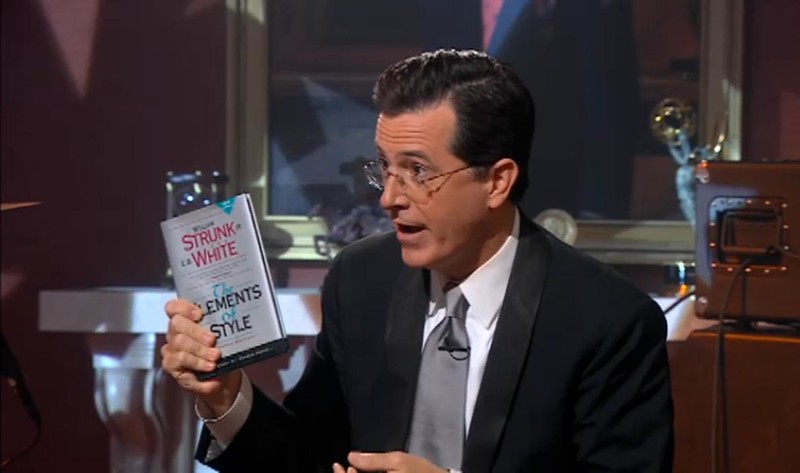How the Elements of Style is Wrong for Pro Writers


Imagine the Old Testament without Abraham or Moses, the New Testament without Christ’s resurrection, a Los Angeles Laker program or website without LeBron James, a McDonald’s without French fries, or an Xbox console that didn’t let you play Fortnite. That’s the reality for professional writers who read William Strunk Jr. and E.B. White’s The Elements of Style. The popular writing guide omits the most important writing principle, the superstar principle, the principle that wins you readers and paychecks alike.
Don’t get me wrong. The Elements of Style contains invaluable lessons for writers of all stages:
“Use the active voice.”
“Put statements in positive form.”
“Omit needless words.”
“Avoid a succession of loose sentences.”
“Place the emphatic words of a sentence at the end.”
A sentence by a writer who, for whatever reason, knew not and abrogated these rules and made the decision to determine for herself the not unimportant guidelines she utilized would be, it seems to me, a not unchallenging one for readers, which is not something that one should do if one can help it at all possible … See what I mean?
To be sure, The Elements of Style has detractors. A few literary dissidents object to the book. Some English teachers ignore it.
Yet the book has many more admirers. Novelists Stephen King and Dorothy Parker were. The Guardian newspaper was. Ranking The Elements of Style as the 23rd greatest book in the English language, the newspaper said the book “will help the ordinary beginner to find clarity, brevity, and candor in self-expression.” Time was another fan. Putting the book in the top 100 non-fiction books of all time, the magazine said the book “was a timeless reminder of the simplicity of proper writing.”
Clarity, organization, and persuasion—The Elements of Style emphasizes these three writing principles succinctly and well. That’s not the book’s problem for aspiring and professional writers. The book’s problem is its treatment of the fourth writing principle—give substance or value to your readers.
The Elements of Style assumes readers’ interest, assumes readers will browse the writer’s article or book, assumes readers will stick with the text. In the introduction, New Yorker writer E.B. White, a student of Professor Strunk’s at Cornell at the end of World War I, described the book’s attitude to readers this way:
All through the Elements of Style one finds evidences of the author’s deep sympathy for the reader. Will felt the reader was in serious trouble most of the time, a man floundering in a swamp, and that it was the duty of anyone attempting to write English to drain the swamp quickly and get his man up on the dry ground, or at least throw him a rope. In revising the text, I have tried to hold steadily in mind this belief of his, this concern for the bewildered reader.
Who was this bewildered reader? None other than Professor Strunk himself. Here he was an English professor at an Ivy League college in the early 20th century … and damn if he could read the papers from students that crossed his desk! Where were the writing guides to help him out? Why couldn’t his students follow elementary rules of style? …
Based on the available evidence, Professor Strunk was determined to avoid being bewildered or even inconvenienced by excess verbiage. Mr. White recounts Professor Strunk traveling to the school’s alumni office downtown once in protest of its use of the word “student body” and suggesting the editors replace it with “studentry” instead. A grander example of his determination was a 43-page, privately-published writing pamphlet he distributed to his students. He called it “The Elements of Style” or “the little book.”
In short, Professor Strunk was an exaggerated example of the class of readers all of us grew up with. He was a teacher paid to read our stuff. Our teachers didn’t need an incentive to read our papers. If they stopped reading or didn’t bother at all, they would put their job at risk … What, you didn’t even read my story?!, a student could say to the teacher …
That’s a sobering lesson. As great and wonderful as teachers can be, at some level they are simply doing their job. They were paid to care about the thoughts in our heads, the musings and expressions we put to paper.
The trouble is, the schooling can produce a bad mental habit. We equate our readers with our old teachers … They don’t care what I write as long as it’s clear, well organized, and persuasive!
While understandable, the attitude is egotistical. A pithy, well-structured, and irrefutable essay about the virtues of a writing desk would interest no one outside your immediate family, and possibly not even them.
Those are not the elements of professional success as a writer. Those are the elements of rejection letters, pink slips, and unreturned query letters. We could say, and it’s true, The Elements of Style was not designed for professional writers, only for beginners. Whatever the case, Professor Strunk’s “little book,” his parvum opus, as E.B. White wrote in a cheeky aside, fails to help the bewildered, professional writer struggling to place his or her stories or get a wider audience one bit.
-30-
This is the first of a two-part series. In the next post, I will examine the elements of the fourth writing principal: Giving value to your readers.

0 Comments